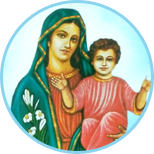History
A BRIEF HISTORY OF THE CHURCH

The inscription on the stones in the Haikalah of the church is in ancient script-nanum monum- that went into discus, about 600 years ago and the information it contained authenticate that the church was established more than 1000 years ago. First made of bamboo and mats of bamboo, it was renovated in different phases. In 16 the century it was reconstructed in the Portuguese fashion. The construction of the present church was completed in 1954.
Thekkumkur, a province in the state Cheraman permal, extended from Aranmula from the southern side to Kanakkari, a place on the northern side of Ettumanoor. Manarcad also was a part of this province. Of the two capitals of Thekkumkoor, one was Chenganassery and the other Kottayam. In these days places such as Nattassery, Parampuzha, Thiruvanchoor and Manarcad were ruled by a branch of Thekkumkur known as Edathil Thamburakkal Manarcad and the neighboring places, in those day, were a center of Hinduism and Hindu culture. There indications that in this place there were about twelve temples within a square kilometer area. This area was overgrown with a kind of acaia (Acacia intsia and Acasia reshiama)and other thorny bushes and inhabited by ferocious wild animals.
In 52 A.D. St. Thomas came to malankara, preached the Gospel and baptized many families. Priests were chosen from Brahmin families Sankarapuri, Pakalomattom, Kalli and Kaaliankal, and churches were established in different parts of Kerala. In the Mahadevar town, the the capital of the State, there were many Christians. There occurred sporadic feuds and clashes over question of business monopoly among the jew, Muslims and Christians of this area. In one such clash the capital town was burnt to ashes and in consequence the Christian population field the city and migrated to different places. For their business interests many of them settled in places close to river mouths. Many Christians, including some members of the Pakalomattom family settled in Kaduthuruthy and nearby places such as Kuravilangadu, Athirampuzha, Vadakara, Ramapuram and Pala. They also established churches in these places. Some Christians from the Vadakkumkoor region settled in places like Thiruvanchoor, Parampuzha, Nattassery, Manarcad, Maalam, Kuzhippurayidam, Velloor, Pampady, Thottakkadu, Vazhoor, Amayannoor etc… and involved themselves in agricultural occupations.
THE VISION AND THE ESTABLISMENT OF THE CHURCH
In the early days there were about ten or twelve Christian families in the Manarcad area. When they acutely felt the need of a church for offering prayers and for receiving the holy sacraments they assembled in prayer and spent days fasting. On the eight day each of them had a vision; on sharing the details they understood that all of them had the same vision. In the vision they saw a white cow and its calf lying in a forest area overgrown with a certain species of acaia (Acacia intsia and Acasia reshiama)and other thorny bushes and were asked to build on that spot a church in the name of Holy Mother and son. They went in search of the cow and calf and found them at the place where the church of Manarcad is presently situated. Later they built there church in the name of the Holy Virgin and the Son.
FROM THE ANNALS OF HISTORY
The inscription on the stones in the Haikalah of the church in the ancient script nanum monum (Vattezhuth), logical experts, revealed that they were inscribed bed in A.D. 910 and A.D. 920. The royal swords are also kept in the church, which are believed to be given to the church by the king for the Protection of church parishes.
During the year 700 of Malayalam Era (Kollavarsham) the then ruled King of Vadakkumkoor had a discontent with Christians. It was a period of great torment for Christians and the King showed hostility to the Christians and their possessions, including Manarcad church which was as the border of neighboring country, Thekkumkoor. The then King of Thekkumkoor, who maintainend a special relationship with Christians had given the swords to the church for its protection.










